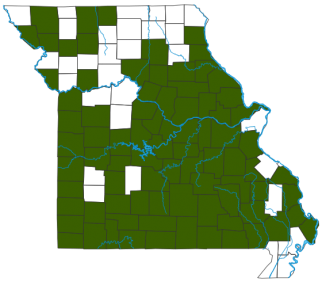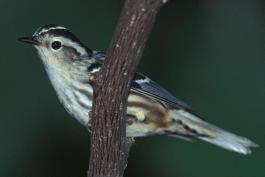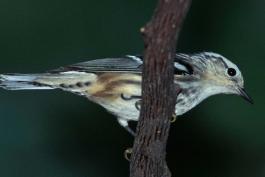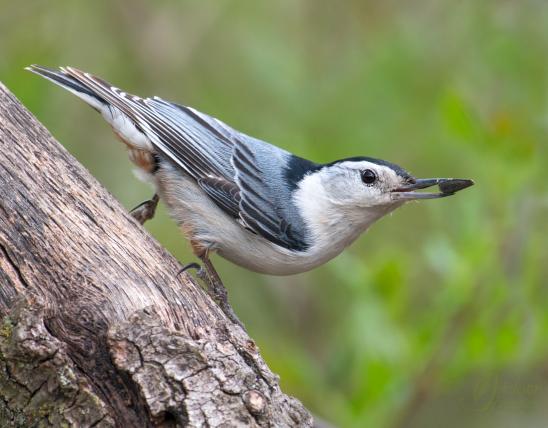
The black-and-white warbler adult upperparts are black-and-white striped, with white wing bars. Underparts are white. Male has a black throat and heavy streaks on the breast and sides. Female has grayish streaking on sides of breast and a gray cheek patch; often she has a faint buff color on the flanks. This warbler creeps on tree trunks and branches like a nuthatch or creeper. The song is a high, 3-second-long series of repeated two-syllable phrases, each with an accented first syllable: weesee, weesee, weesee, weesee. The call is a loud, somewhat metallic tsimp or a lispy see-see.
Similar species: Nuthatches and brown creepers also creep around on tree trunks and branches, but they do not share the black-and-white streaked plumage: Brown creepers are brown-patterned, and our nuthatch species have gray backs. Two other warblers might possibly be confused with black-and-white warblers: The yellow-throated warbler shares the habit of creeping on trees and has white- and black-streaked upperparts, but it has a bright yellow throat and upper breast. Male blackpoll warblers, in spring breeding plumage, have similar white-and-black streaking, but they are distinguished by their solid, clear white cheek patch, which contrasts strongly with their solid black cap above and black moustache streak below.
Length: 5¼ inches.

Statewide migrant.
Habitat and Conservation
Occurs in forests and woodlands where it creeps along tree trunks and branches, foraging for insects. Interestingly, in their tropical overwintering range, which extends from Florida into the northern parts of South America, black-and-white warblers live in a variety of habitats: urban lawns, orchards, mangroves, and wetlands, as well as forests.
Food
Like a nuthatch or creeper, it forages for insects by creeping around tree trunks and branches, searching for insects hidden behind loose bark. The forceps-like bill is excellent for extracting their food — often the caterpillars and pupae of moths and butterflies, plus ants, spiders, flies, and a variety of beetles and their larvae — from cracks and crevices.
Status
Common transient statewide; as summer resident, uncommon in southern Missouri and rare in the north. This species is the only member of its genus, Mniotilta. The genus name comes from Greek words for “seaweed” and “plucking,” and it refers to this bird’s habit of picking among moss and tree bark for food. This life-style is expressed physically in the bird’s unusually long hind claws and stronger, heavier legs, which set it apart from other wood-warblers, which spend more time simply perched on branches.
Life Cycle
Black-and-white warbler numbers peak in Missouri in late April and early May, as they fly through our state on their way north. Some stay over the summer and breed. Nests are build on the ground, in a hidden place at the base of a tree, rock, shrub, or other structure. Their cup nests are made of dried leaves, grasses, and bark, and are lined with moss and other soft materials. A typical clutch contains 4–6 eggs, which hatch after 10–12 days. The young are able to leave the nest some 8–12 days after hatching. In early September, migrants come back through on their way back south. This species is absent from our state from mid-October through the end of March.
Human Connections
Populations of this species are apparently secure, but human activities that harm other migratory songbirds also harm this one: forest fragmentation (the division of forests into smaller and smaller parcels), and persistent insecticides, which build up in insect predators’ bodies. Also because they are nighttime migrants, they sometimes suffer fatal collisions with tall buildings and other tall structures.
Ecosystem Connections
Black-and-white warblers eat many insects, such as wood-boring beetles and weevils, that are injurious to trees, helping to keep their numbers in check. When yellow-bellied sapsuckers drill holes in trees and sap seeps out, attracting ants and other sweet-loving insects, black-and-white warblers sometimes partake of the insect bounty.




About 350 species of birds are likely to be seen in Missouri, though nearly 400 have been recorded within our borders. Most people know a bird when they see one — it has feathers, wings, and a bill. Birds are warm-blooded, and most species can fly. Many migrate hundreds or thousands of miles. Birds lay hard-shelled eggs (often in a nest), and the parents care for the young. Many communicate with songs and calls.
























